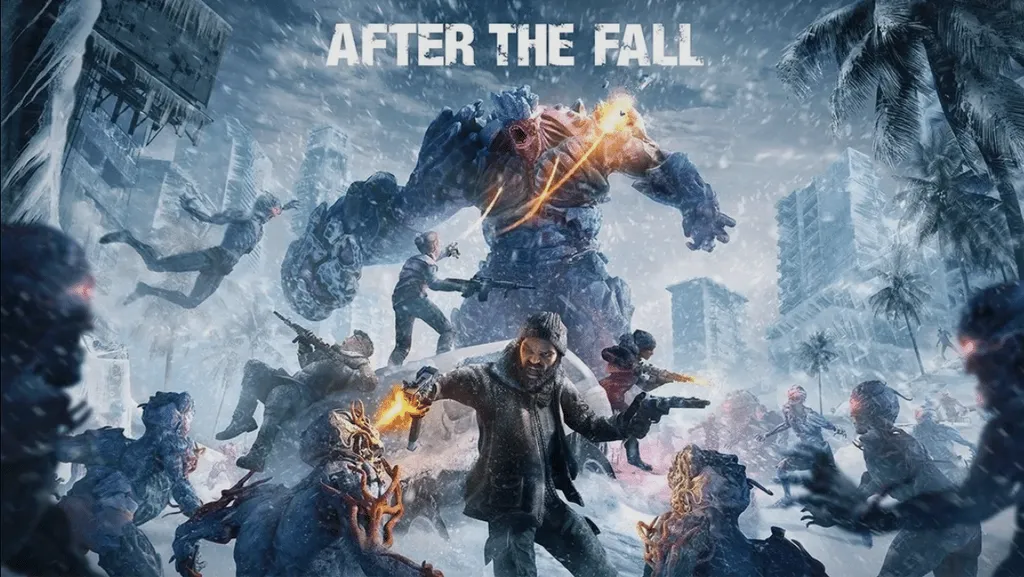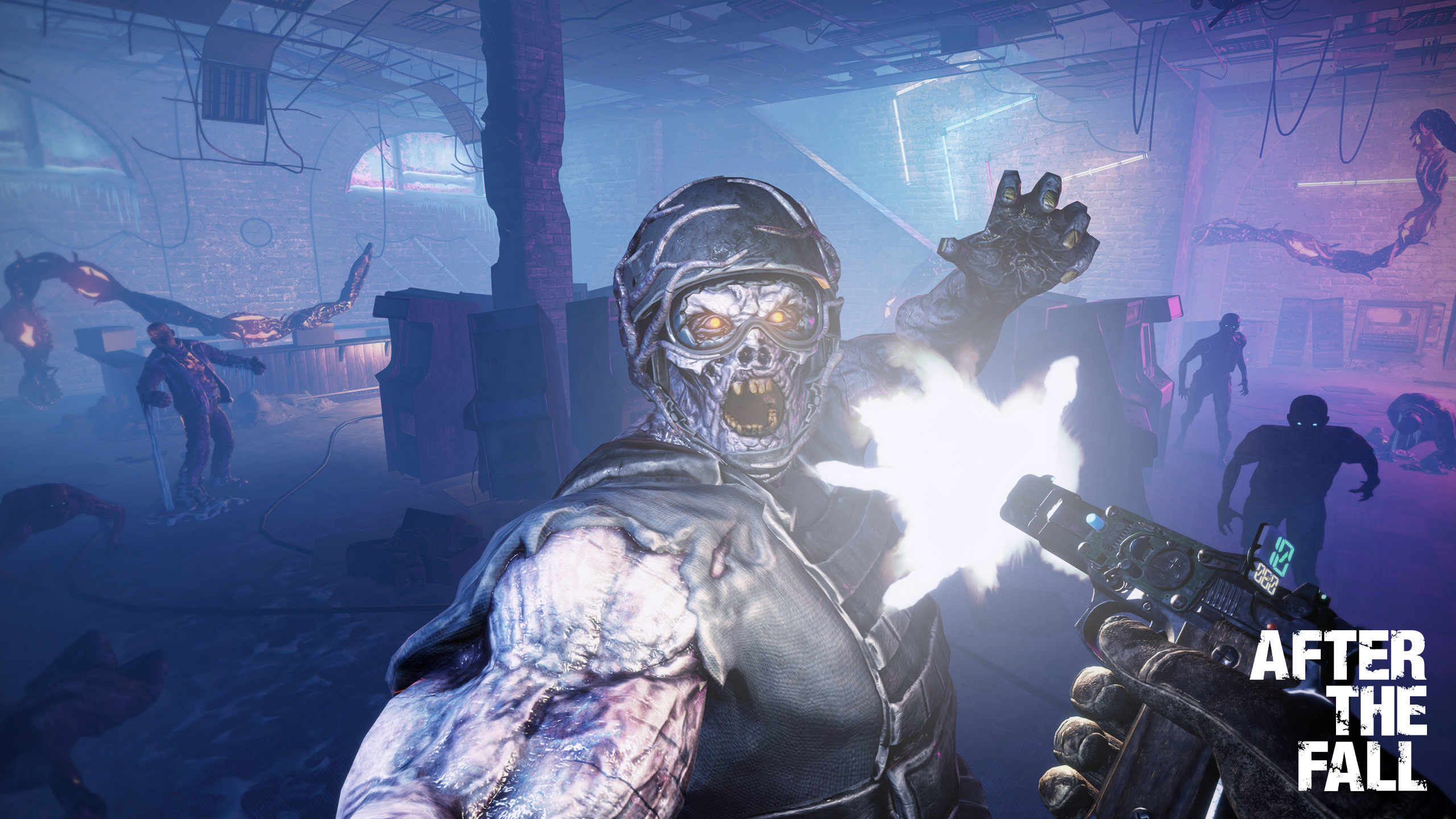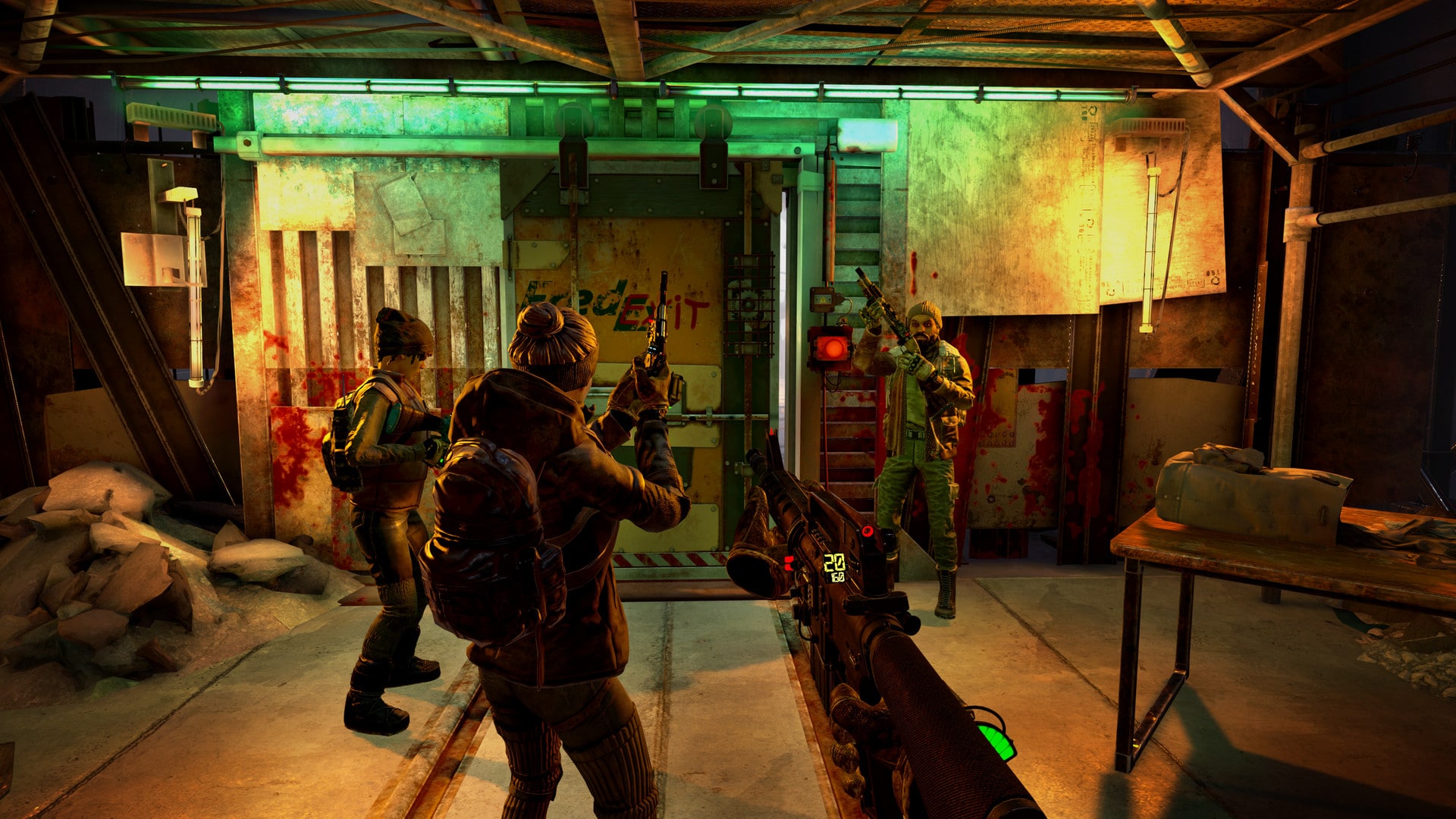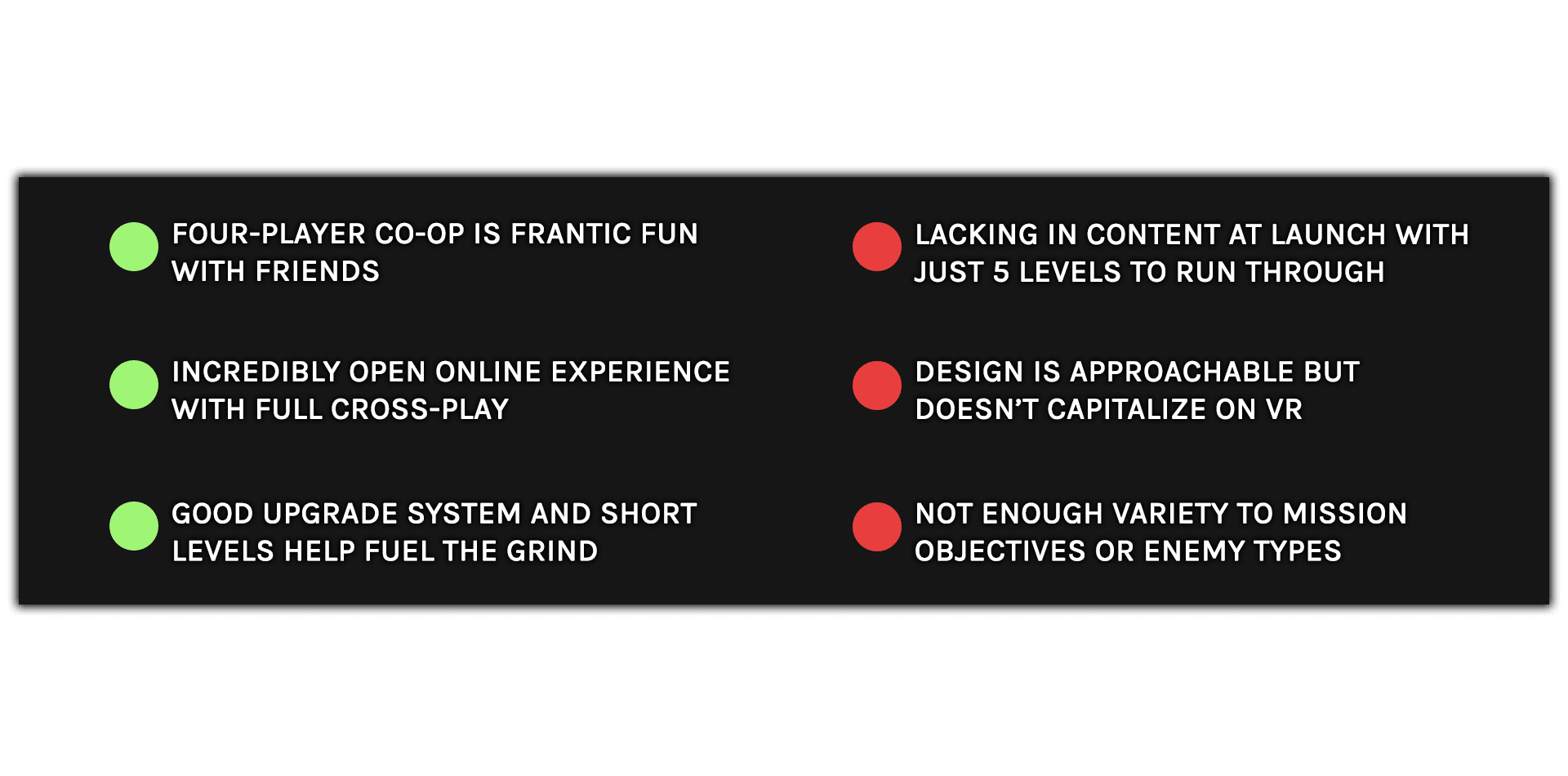After The Fall’s straightforward gameplay lacks variety and content but extensive online support makes for a frantic, mindless good time with friends. Read more in our After The Fall review.
You’d be a liar if you said the Snowbreed of After The Fall hadn’t made you jump at least once. Vertigo Games’ latest zombie shooter is as similarly unconcerned with quick frights as the 5-year-old Arizona Sunshine, but it’s tough to tackle one of the game’s 20-ish minute scavenge missions (known as Harvest Runs), without letting out at least one unexpected squeak of surprise. It’ll happen when you round the corner into a swarm of enemies (affectionately called ‘Snowies’), or turn your back to find yourself dwarfed by one of the game’s many minibosses.
It’s a good reminder that, while this latest in a recent surge of Left 4 Dead imitators isn’t the most immersive or intricate VR experience out there, there’s still plenty to be gained from just taking our favorite genres and transplanting them into headsets. After The Fall does this well.
[vc_row][vc_column][vc_cta h2=””]After The Fall Review – The Facts
What is it?: A co-op shooter in which up to four players tackle repeated ‘runs’ of levels to scavenge supples in a zombie-infested LA.
Platforms: Quest 2, PSVR, PC VR (Oculus Quest 1 coming 2022)
Release Date: December 9th (December 7 with pre-order access)
Price: $39.99[/vc_cta][/vc_column][/vc_row][vc_row][vc_column][vc_column_text]
At its core, Vertigo’s latest feels substantially more familiar than other recent VR hits. In some ways, the game is more of a spiritual successor to L4D than even Back 4 Blood, a game with a direct familial link to Valve’s zombie series. At launch After The Fall has a set of five Harvest Runs with four difficulties to tackle in groups of four players (AI fills in if you want to play solo or with fewer friends). An introductory ‘campaign’ takes you through each environment before you’re let loose to revisit each level, earn more Harvest (the currency traded for weapons and items in the surprisingly efficient economy of a frozen-over LA) and grab weapon upgrades that will help you with harder difficulty modes.
And, well, that’s pretty much it. After The Fall’s appeal is more about jumping in with friends and having fun whilst grinding out new weapons and gear than it is making your way through a cinematic shooter story filled with immersive moments. Your interest in the game will entirely hinge on how much that idea appeals to you but, given the lack of quality long-form co-op shooters available to VR players, I’m willing to bet you’ll at least want to take a look.
It doesn’t take long to find the game’s groove. In fact, if you’d have told me this was a port of an existing flatscreen game, I’d have probably believed you; most weapons feel light as a feather, you can comfortably aim from the hip for pretty much the whole game and there’s even a near-instant reload option that sees you swinging your weapon near your chest, Arizona-style. You can switch this out for an immersive reload system closer to, say Medal of Honor or Sniper Elite VR, but we’re a long way from the weighty, more realistic zombie survival of The Walking Dead: Saints & Sinners or the more grounded, believable shootouts of Half-Life: Alyx.
In other words, when it comes to core design, After The Fall really hasn’t moved on too far from 2016. This, in part, seems intentional.
This is an accessible shooter that casts its net wide, offering just the right balance of fun and challenge no matter your skill level. It’s a sprint more than it is a marathon; each run starts you off in a safe room — again, a lot of the game feels directly lifted from Left 4 Dead — and you’ll have about 5 – 10 minutes of gameplay between you and the next checkpoint. In that time you’ll run through the same level layouts (with some small randomized elements), with Snowbreed pouring out of holes in the ceiling and cracks in the walls. Dealing with them isn’t about strategy so much as how quickly you can pull the trigger.
Every run Harvest Run in After The Fall essentially plays out in this rollercoaster pattern. You have a few minutes of downtime as you gather ammo before sharply reacting to frantic bursts of action in which you’ll be constantly communicating about where your enemies are coming from. Things can quickly take a turn for the worse as enemy numbers overwhelm, and you’ll likely find yourself starting on the easiest difficulty, Survivor, to earn gear that helps you push on through to harder modes. Special enemy types, meanwhile, are an assortment of familiar bullet-sponges and explosive types, mixed with end-of-level bosses that require you to concentrate fire on particular areas.
But, intentional or otherwise, there’s just no escaping just how repetitive and straightforward the game can be. Having now finished each of the five levels included at launch and revisted them on multiple different difficulties, I was surprised at just how simplistic overall mission design is. I’m really not exaggerating when I say there’s no variety in After The Fall, beyond facing different waves of Snowbreed. There are no special objectives like escorting NPCs or carrying special items, no standout set pieces save for a final confrontation and even the bosses and minibosses — around 4 types in total — are recycled constantly over the course of the handful of levels.
Environments, meanwhile, don’t really distinguish themselves from level-to-level, save for a trip to Chinatown and a series of battles atop a skyscraper, and there’s not much in terms of enemy variety in the game to really change up tactics. It’s true that Vertigo was never aiming for a varied, linear campaign, but even compared to the original Left 4 Dead, After The Fall is too simplistic in its mission design.
It’s fortunate that the mindless core gameplay is pretty engaging with friends, then. Similar to the way Demeo’s social VR support props up an otherwise decent tabletop game, co-op turns After The Fall from what would be a dull, one-note solo shooter into a fun romp. Accept the game for what it is, and you’ll enjoy barreling into hordes of Snowbreed time and again. But, even then, the game doesn’t really capitalize on the platform. Aside from the usual thrills of aiming with your hands, throwing grenades or reviving teammates with a stab of a syringe, After The Fall is light on interaction and immersion, with the real VR kick coming from the dread of seeing zombies rush towards you. But, what the game might lack in groundbreaking VR design, it does partly makes up for in other areas.
For starters, After The Fall’s social offerings are unmatched. Whenever you jump into the game, you’ll load into a hub world with 32 other players across a wide variety of headsets. From Quest 2 to PSVR to basically the entire gamut of PC VR devices, the game supports full cross-play, and it’s a truly incredible achievement, though it does mean having to deal with lots of unwanted third wheels when first loading into the game and trying to locate your friends.
Making friends and partying up across headsets also works well, at least when you’re one of only a handful of players. I could quickly jump into a hub, find a friend with their username above them and then point and click to open up a menu, add them to my friend’s list and then invite them into a party. It works really well and a lot of other games — not to mention even entire online social platforms — should learn from this template.
That said the system does have its quirks right now. People seemed to be inexplicably able to join my party and, from what I could tell, there’s no way to jump online and just have access to my friends, thus evading a cascade of friend requests. Hopefully these options and issues will be addressed in the near future, though.
[vc_row][vc_column][vc_cta h2=””]After The Fall Review – PC vs Quest
The mere fact that Vertigo managed to cram all of After The Fall — a game that started development long before the release of the original Quest — onto Quest 2 is nothing short of phenomenal, let alone that you can then play all three versions of the game together with cross-play. And Vertigo has also managed to keep feature parity between these versions; Quest 2 has the same enemy count as PC and, I promise you, you won’t find a standalone shooter with more enemies on-screen at once.
The game even manages to hold up in most areas on the visuals front. Gun models and environments aren’t as evolved as they are on PC but still carry a lot of impressive detail for the platform. You’ll also notice the quality varying from level to level, with the final skyscraper scene devoid of weather effects on Quest. The one area where Quest really suffers, though, with is enemy character models. They look like cardboard and often stick out like a sore thumb amongst the game’s snowy environments. It’s a shame, given they’re what you’ll spend most of your time looking at, but an understandable compromise to help the game keep pace with the other versions. There are also some more advanced collision systems on PC that haven’t made it into Quest, like guns pushing away from each other when dual-wielding.
We’ll be updating this section with PSVR impressions at a later date.[/vc_cta][/vc_column][/vc_row][vc_row][vc_column][vc_column_text]
I also enjoy the game’s upgrade system, even if it’s on the stingy side right now. Harvest is used to buy new weapons and attachments, which you’ll unlock the ability to buy by recovering floppy disks whilst out on missions. Better upgrades mean better weapon performance, which in turn makes harder difficulties easier and lets you push on to grab yet better attachments. The system isn’t exactly generous, though, as you’ll get lots of duplicates when you’re out on runs and weapons and attachments cost a heck of a lot of money. It’s also a shame there isn’t a more personal sense of progression to let you upgrade health or inventory slots.
With all that said, there simply isn’t enough game to After The Fall to really deliver on its full potential at launch. Each of the five levels takes about 15 – 20 minutes to finish and, once you’ve played through them, all that’s left is to do it all again. Granted that grinding and revisiting levels is the name of the game here and I don’t doubt that some people will happily surrender to that gameplay loop for hours on end, but it feels like the game needs at least double the amount of content it’s currently packing to really sustain players for months or even weeks on end. Watching how the game’s roadmap rolls out in the months to come will be crucial to the success of After The Fall.
It’s a little puzzling when you consider just how long the game has been in development (though no doubt the sudden success of the Quest platform explains the game’s year-long silence in 2020) but it’s even more curious when you consider some features like melee combat, which I tried in a build-in 2019, are completely missing from the final product. Just a few months ago the studio also told us that this demo was a “good representation” of what the final game resembled, but it appears that’s not quite the case. That said, Vertigo has suggested that elements like these might return in future updates.
After The Fall Review: Final Thoughts
After The Fall is painfully close to being VR’s staple co-op shooter, but Vertigo will need to prove out the next few months with a solid roadmap if it’s to reach that bar. Its mindless brand of action isn’t half as intricate as other recent VR games and anyone that doesn’t enjoy the grind of a looter shooter should steer clear, but it’s undeniably fun to play with friends and the lure of new weapon attachments kept me coming back for Harvest Runs. The game’s greatest achievement is its flexible online play, with extensive cross-play support that makes it easy to party up with just about any VR headset owner. But it’s also an inarguably simple experience that doesn’t have anywhere near as much content or variety as it needed at launch. That makes the prospect of possibly paying for more maps in 2022 a bitter pill to swallow.
For now, After The Fall is a good game with a lot of room to grow. We’re just waiting for its full potential to thaw.
For more on how we arrived at this rating, read our review guidelines. What did you make of our After The Fall review? Let us know in the comments below!






























